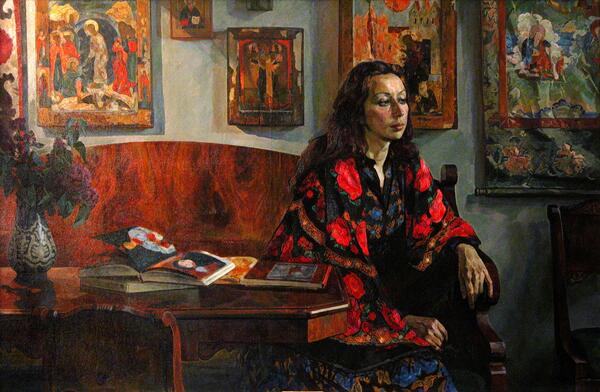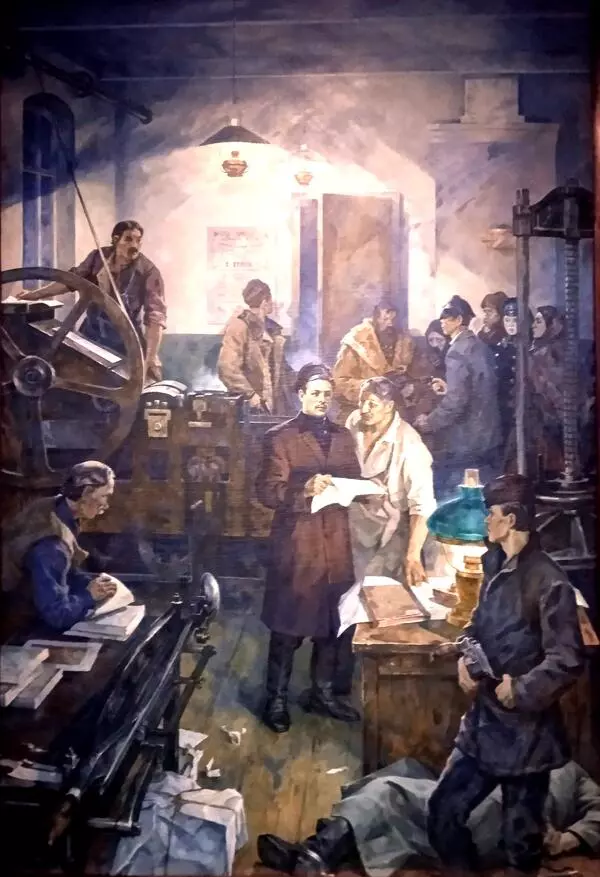In each painter’s art it’s especially interesting to see the works stylistically standing out and uncovering the author’s range. The painting On a White Night by Leonid Kabachek can be referred to such works.
Leonid Kabachek was a Soviet painter, an Honoured Artist of the RSFSR. His youth took place at the time of the Great Patriotic War, where he participated and came as a soldier to Warsaw. As many other Sixtiers painters, Kabachek especially appreciated Mikhail Vrubel and Filipp Malyavin for their power of colours and faceted crystal-clear form. He managed to rethink and turn their manner into his own style. In choice of his plots the painter concentrated on a social aspect, such as village and life of a working class. He painted a lot of densely populated paintings on village and city holidays without avoiding portraits. The personality with their small and big victories and worries steps on the foreground in Kabachek’s art. Probably that is why this painting is one of the favourite ones of the Kurgan museum visitors.
On his big canvases, where life was shown in its festive angle (such as Horserace Winners), Kabachek used bright and joyful colours.
One shouldn’t think of Leonid Kabachek as a “propaganda outlet” of the ideas of socialistic art. The whole series of his paintings reflects severe everyday life of his compatriots, historical dramas of the 1930s. In his painting Year 1930 he showed the whole drama of collectivization, which got him on the party’s bad side. The painting was banned and only saw the light in late 1980s.
Keeping this in mind it’s especially curious to look at the painting On a White Night. It was painted in 1979 during the matured period of both Kabachek’s art and art of the Leningrad school of painting. By the period the artist had already stepped away from the Severe Style to decorative painting full of colour and texture. There’s no social background or plot in this painting. The whole plot is limited by the part of a room where a young woman in the Pavlovo Posad shawl is sitting in an old couch, surrounded by icons. The artist bravely combined the quiet contemplativeness of home intimacy with certain formality of a portrait. The title On a White Night itself is especially poetic. We can’t see a window, a clock or anything else to get the time of day or a season. Only the blossoming lilac can give us a hint. And henceforth, putting the title on a plot, our imagination adds the details itself. We immerse ourselves in atmosphere of art reign, spiritual concentration inspired by poetic time of the white nights. The open books with reproductions of paintings are on the table in front of the woman, she is herself surrounded with art and antique furniture. And, as it’s been said, the person with their life was very important for Kabachek and, probably, on the painting we see the whole human’s world as the highest value.
Leonid Kabachek was a Soviet painter, an Honoured Artist of the RSFSR. His youth took place at the time of the Great Patriotic War, where he participated and came as a soldier to Warsaw. As many other Sixtiers painters, Kabachek especially appreciated Mikhail Vrubel and Filipp Malyavin for their power of colours and faceted crystal-clear form. He managed to rethink and turn their manner into his own style. In choice of his plots the painter concentrated on a social aspect, such as village and life of a working class. He painted a lot of densely populated paintings on village and city holidays without avoiding portraits. The personality with their small and big victories and worries steps on the foreground in Kabachek’s art. Probably that is why this painting is one of the favourite ones of the Kurgan museum visitors.
On his big canvases, where life was shown in its festive angle (such as Horserace Winners), Kabachek used bright and joyful colours.
One shouldn’t think of Leonid Kabachek as a “propaganda outlet” of the ideas of socialistic art. The whole series of his paintings reflects severe everyday life of his compatriots, historical dramas of the 1930s. In his painting Year 1930 he showed the whole drama of collectivization, which got him on the party’s bad side. The painting was banned and only saw the light in late 1980s.
Keeping this in mind it’s especially curious to look at the painting On a White Night. It was painted in 1979 during the matured period of both Kabachek’s art and art of the Leningrad school of painting. By the period the artist had already stepped away from the Severe Style to decorative painting full of colour and texture. There’s no social background or plot in this painting. The whole plot is limited by the part of a room where a young woman in the Pavlovo Posad shawl is sitting in an old couch, surrounded by icons. The artist bravely combined the quiet contemplativeness of home intimacy with certain formality of a portrait. The title On a White Night itself is especially poetic. We can’t see a window, a clock or anything else to get the time of day or a season. Only the blossoming lilac can give us a hint. And henceforth, putting the title on a plot, our imagination adds the details itself. We immerse ourselves in atmosphere of art reign, spiritual concentration inspired by poetic time of the white nights. The open books with reproductions of paintings are on the table in front of the woman, she is herself surrounded with art and antique furniture. And, as it’s been said, the person with their life was very important for Kabachek and, probably, on the painting we see the whole human’s world as the highest value.



